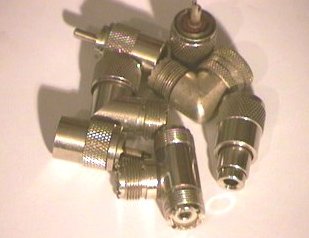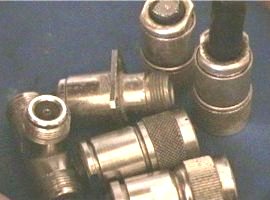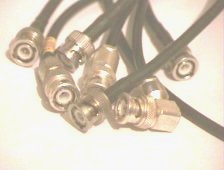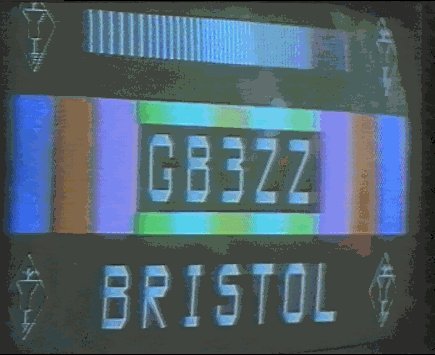 |
 |
 |
Connectors
PL259

Their
name belies their function, since these well known connectors are far
from suitable for UHF use, let alone the lower microwave bands. The
plug is known as the PL259, the corresponding socket as the S0239. They
were developed before the last war for video connections in radar sets,
and are still commonly used on video monitors and cameras. This is about
the only application for which they are suitable, despite their widespread
appearance as aerial sockets on HF and 2m Amateur Radio rigs. Because
they are not a constant impedance device, they perform poorly at VHF
frequencies and above. PL259's are avilable in a wide variety of styles,
to suit both 10.3 and 5.5 mm diameter cables, although none of the types
that I have seen are waterproof.
"N"
Type Connectors

N Connectors are
the main type used for 23 cm equipment. The N stands for Navy, an indication
of for whom they were originally developed. They are mostly used for
10.3 mm diameter cables, although versions are available for 5.5 mm
diameter cables. There are also special types for use with Heliax, Westflex
103 and the Japanese FB series cables. They feature a threaded locking
collar, and internal gaskets mean that in theory the joint between cable
and plug and plug and socket are waterproof. That said, I would not
trust only the internal gaskets for a connector located permanently
outside, and would recommend either several layers of PVC tape topped
off with a coat of varnish, or a tightly bound layer of self-amalgamating
tape. These plugs can be used up to several GHz and are ideally suited
for 23 cm use. However, they are available in two impedances, 50 W and
75 W, both of which are mechanically and electrically mutually incompatible.
The 75 W type can usually be recognised if it is not marked, by its
notably thinner centre pin. Beware of cheap plugs at rallies, they are
often the much less useful 75 W type. If you cannot establish the impedance
for certain, I would leave well alone since a 75 W plug is useless in
a 50 W system. Although these plugs are made by a wide variety of companies,
brands which I have found reliable include Greenpar, Transradio, Amphenol
and Kings. I prefer the type with a captive centre pin. The centre pin
is mechanically locked between two peices of dielectric, and cannot
move within the body of the plug. In the non-captive variety, the centre
pin is held in position only by the inner conductor of the cable. Whilst
this is more satisfactory with 10.3 mm diameter cables and their sturdy
innder conductors than it is with BNC types, over a period of time the
centre pin can be forced out of position, resulting in a less than perfect
connection with the plug. Good quality N plugs cost about 4 times as
much as a PL259.
BNC
Type Connectors

The Bayonet
Navy connector is a smaller constant impedance device, usually used
with 5.5 mm diameter cables. Versions are available for use with 10.3
mm diameter cables, as well as smaller diameter cables. The plug features
a bayonet locking collar, although there is also a TNC with a threaded
locking collar. Internal gaskets make the joint between cable and plug
waterproof, but the joint between plug and socket is not. Once again
there are two impedances of 50 and 75 W available, and the same comments
as for N connectors above apply.
The RF performance of these plugs is inferior to that of N types, but
they can be used at 23 cm for short links within or between adjacent
items of equipment. The point about captive centre pins is very important,
since I have found the non-captive types very difficult to assemble
and very poor in service. A good BNC plug is about twice the cost of
a PL259. Whilst there are a number of other RF connectors commonly used
in professional circles, most Amateur 23 cm stations are restricted
to the N and BNC types.
SMA,SMB,SMC
Connectors
The SMA, SMB and
SMC range of connectors are to be used at higher frequencies typically
around 10GHz plus. They can often be found at Radio rallies with semi-rigid
cable already attached for a couple of pounds each. They make excellent
short inter-connection leads for your homebrew UHF/SHF equipment.


|
 |
 |
 |





